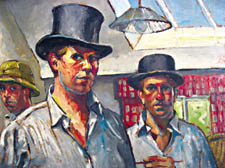|
|
 |
| |

A self-portrait of the artist
|
Unsung hero’s legacy
Tales of wartime heroism and unseen paintings have been found in a cluttered studio after an artist’s death, Dan Carrier reveals
AN extraordinary find awaited Hampstead auctioneer Colin Smith as he looked over the contents of a small studio above a Swiss Cottage mews garage, whose unassuming occupier – one Gordon Bennett – had died.
Stacked up against every available surface, found 500 paintings, books, easels, pots of paint and brushes – and two Second World War flying logs.
As he examined the shambolic miscellany left by the old man who lived alone, the rich life story of Gordon Bennett emerged.
Born in Sheffield in 1921, he was a student at Sheffield College of Arts and Crafts until the war when he left to join the RAF as a pilot.
After the war, he finished his studies in Sheffield and then moved to London to complete his teaching qualification at the Institute of Education and the Sir John Cass Institute. He taught art at a Montessori school and at a special needs school for boys the East End and later at the Islington Institute. After his retirement, he offered private lessons to students at his cluttered home in St John’s Wood.
When he died last December, leaving no relatives, solicitors dealing with his estate decided to call in Colin Smith to help shift the enormous array of artwork. At an auction last week held at Hampstead Community Centre, his wordly goods fetched £14,000. Every item was sold, his log books being bought by a Canadian collector, while the most expensive of his 500 paintings went for £260.
It soon became apparent to the auctioneers that Gordon Bennett was not simply a teacher, but an accomplished artist and, more surprisingly, a war hero.
The log books told of wartime daring and sang- froid. The Blenheim heavy bomber he was piloting was hit by enemy Messerschmitt, forcing a crash landing in the North African desert. Gordon and his navigator escaped unscathed and then walked through the desert towards the British lines.
On their way they met a Bedouin tribesman who volunteered to lead them to safety. They were fearful they were going to be betrayed – handed in for a reward. But instead the man took them to a road where they flagged down a car. To their astonishment, it was driven by a Reuters correspondent. He put them in the back and drove them to safety.
His log book reads: “December 20. Day ops: Tocra-Benghazi Road. Attacked by 109s at Barce. Port Engine gone. Forced landed at Giagiarama. Walked back three days.” The next entry is just eight days later: “December 28. Day Ops. Dive- bombed a gun emplacement.”
Friends say this was typical of Gordon: he had a zest for life that a crash- landing would not dent.
They tell of a man who never married as he had too many girlfriends to choose from. “Gordon was interested in teaching – but he was more interested in teaching a class full of nubile 17-year-olds,” said a friend who had known him since the 1950s. He was a ladies man – a charming individual, and that was why he never married.”
He was keen on wine and joined a wine-tasting club in the 1950s. They trawled wine cellars in clubs and restaurants and then as the group got to know each other they would hold the boozy sessions at his studio.
These continued right up until his death.
“His home was not in a good state of repair. The roof leaked, and at his raucous parties he eventually had to ask visitors not to dance so wildly in the back bedroom as there was a real danger of the floor collapsing on to the garages below,” said life-long friend Michael Beswetherick.
As Michael recalls: “People were very comfortable with him. He had one pupil who was 100 years old. He commanded tremendous affection among his friends.”
Away from art, he was an expert in architecture and Nick Nullis, his navigator during the war, eventually became an architect. The pair were stationed across the Middle East and held intense discussions about the various merits of the Arab buildings they saw around them.
He was not drawn to a particular style or period of art. Although all the work is accomplished, it ranges from Edwardian-influenced portraits to abstract art that is steeped in mid-20th century Modernism.
“He was so interested in the total world of art and artists that he drank it all in,” said Michael. “It was a pleasure going to exhibitions with him as he just knew so much about the work on display. He would experiment a lot himself, and you can see that in this collection.”
Mr Beswetherick said that the haul of artwork in Gordon’s studio was typical of his friend – to have left them lying there with no will stipulating their destination: “He would have made a terrible businessman. He was unbusinesslike in all of his dealings.” Michael had asked what Gordon would like done with his hundred’s of paintings. He replied: “Oh, I don’t know. I think I’ll leave that up to you.” |
 |
|
| |
|
 |
|

